翻译理论与实践_曾剑平_词语的理解与翻译
- 格式:doc
- 大小:31.00 KB
- 文档页数:3
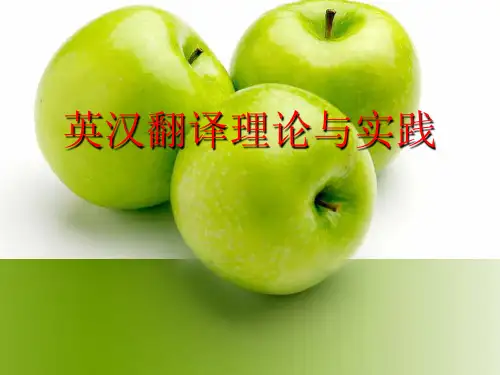

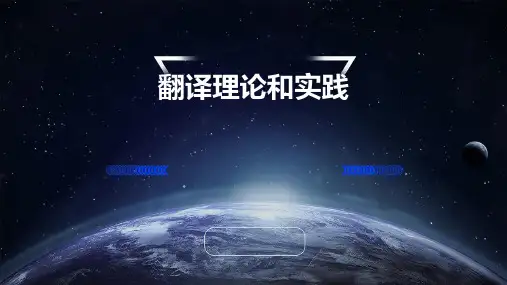
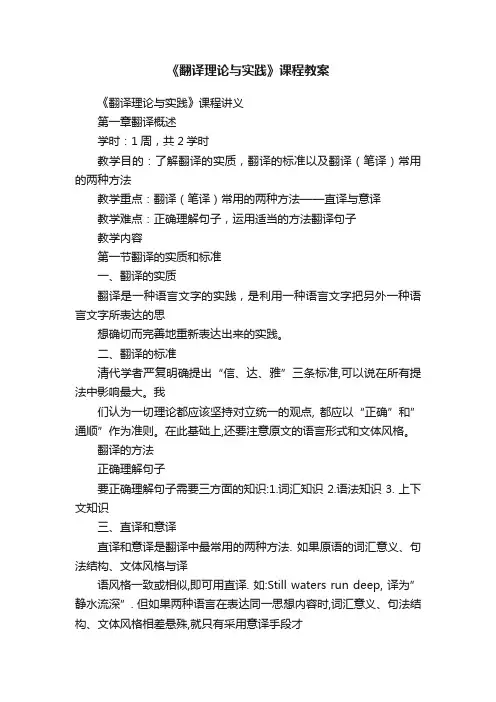
《翻译理论与实践》课程教案《翻译理论与实践》课程讲义第一章翻译概述学时:1周,共2学时教学目的:了解翻译的实质,翻译的标准以及翻译(笔译)常用的两种方法教学重点:翻译(笔译)常用的两种方法——直译与意译教学难点:正确理解句子,运用适当的方法翻译句子教学内容第一节翻译的实质和标准一、翻译的实质翻译是一种语言文字的实践,是利用一种语言文字把另外一种语言文字所表达的思想确切而完善地重新表达出来的实践。
二、翻译的标准清代学者严复明确提出“信、达、雅”三条标准,可以说在所有提法中影响最大。
我们认为一切理论都应该坚持对立统一的观点, 都应以“正确”和”通顺”作为准则。
在此基础上,还要注意原文的语言形式和文体风格。
翻译的方法正确理解句子要正确理解句子需要三方面的知识:1.词汇知识 2.语法知识 3. 上下文知识三、直译和意译直译和意译是翻译中最常用的两种方法. 如果原语的词汇意义、句法结构、文体风格与译语风格一致或相似,即可用直译. 如:Still waters run deep, 译为”静水流深”. 但如果两种语言在表达同一思想内容时,词汇意义、句法结构、文体风格相差悬殊,就只有采用意译手段才能达到翻译标准的要求.练习题:1.Every state is the best judge of what is required to safeguard its national security.2. It is possible that they never imagined that any considerable amount of public opinion would be rallied in their favor.3. We may define chemistry as the science in which we deal with the chemical change as a resultof which it is possible to reform a new substance.4. There was nothing mass produced about the school, but if it was individualistic, it also had discipline.第二章词语理解学时:1周,共2学时教学目的:正确理解词义,并对词义做出判断。
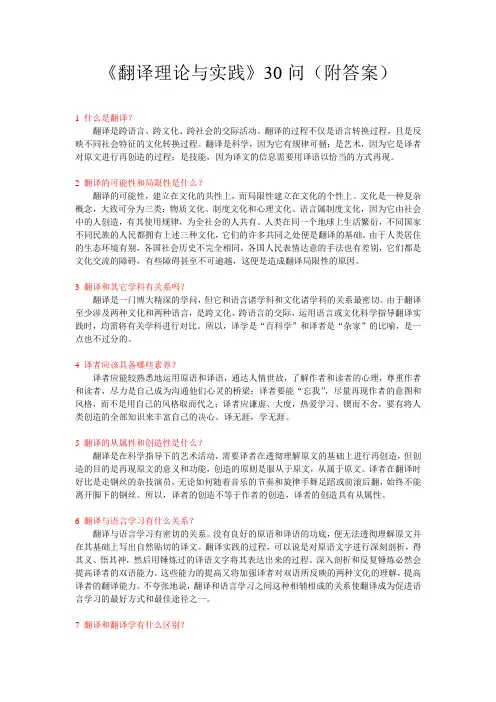
《翻译理论与实践》30问(附答案)1 什么是翻译?翻译是跨语言、跨文化、跨社会的交际活动。
翻译的过程不仅是语言转换过程,且是反映不同社会特征的文化转换过程。
翻译是科学,因为它有规律可循;是艺术,因为它是译者对原文进行再创造的过程;是技能,因为译文的信息需要用译语以恰当的方式再现。
2 翻译的可能性和局限性是什么?翻译的可能性,建立在文化的共性上,而局限性建立在文化的个性上。
文化是一种复杂概念,大致可分为三类:物质文化、制度文化和心理文化。
语言属制度文化,因为它由社会中的人创造,有其使用规律,为全社会的人共有。
人类在同一个地球上生活繁衍,不同国家不同民族的人民都拥有上述三种文化,它们的许多共同之处便是翻译的基础。
由于人类居住的生态环境有别,各国社会历史不完全相同,各国人民表情达意的手法也有差别,它们都是文化交流的障碍,有些障碍甚至不可逾越,这便是造成翻译局限性的原因。
3 翻译和其它学科有关系吗?翻译是一门博大精深的学问,但它和语言诸学科和文化诸学科的关系最密切。
由于翻译至少涉及两种文化和两种语言,是跨文化、跨语言的交际,运用语言或文化科学指导翻译实践时,均需将有关学科进行对比。
所以,译学是“百科学”和译者是“杂家”的比喻,是一点也不过分的。
4 译者应该具备哪些素养?译者应能较熟悉地运用原语和译语,通达人情世故,了解作者和读者的心理,尊重作者和读者,尽力是自己成为沟通他们心灵的桥梁;译者要能“忘我”,尽量再现作者的意图和风格,而不是用自己的风格取而代之;译者应谦虚、大度,热爱学习、锲而不舍,要有将人类创造的全部知识来丰富自己的决心。
译无涯,学无涯。
5 翻译的从属性和创造性是什么?翻译是在科学指导下的艺术活动,需要译者在透彻理解原文的基础上进行再创造,但创造的目的是再现原文的意义和功能,创造的原则是服从于原文,从属于原文。
译者在翻译时好比是走钢丝的杂技演员,无论如何随着音乐的节奏和旋律手舞足蹈或前滚后翻,始终不能离开脚下的钢丝。
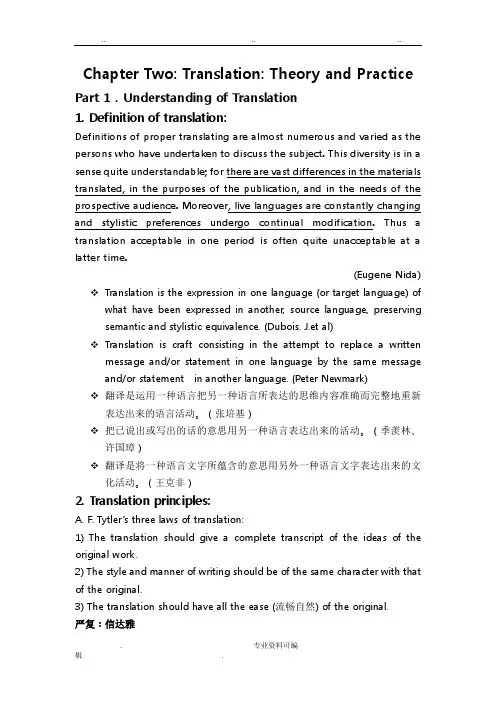
Chapter Two: Translation: Theory and Practice Part 1.Understanding of Translation1. Definition of translation:Definitions of proper translating are almost numerous and varied as the persons who have undertaken to discuss the subject. This diversity is in a sense quite understandable; for there are vast differences in the materials translated, in the purposes of the publication, and in the needs of the prospective audience. Moreover, live languages are constantly changing and stylistic preferences undergo continual modification. Thus a translation acceptable in one period is often quite unacceptable at a latter time.(Eugene Nida) Translation is the expression in one language (or target language) of what have been expressed in another, source language, preserving semantic and stylistic equivalence. (Dubois. J.et al)Translation is craft consisting in the attempt to replace a written message and/or statement in one language by the same message and/or statement in another language. (Peter Newmark) 翻译是运用一种语言把另一种语言所表达的思维内容准确而完整地重新表达出来的语言活动。
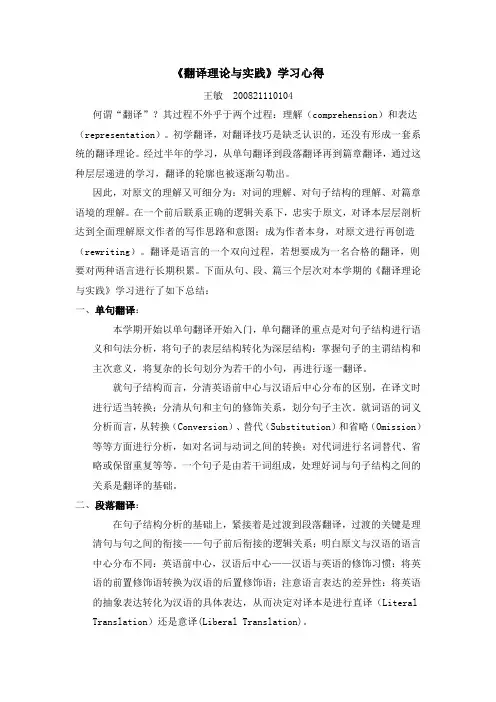
《翻译理论与实践》学习心得王敏 200821110104何谓“翻译”?其过程不外乎于两个过程:理解(comprehension)和表达(representation)。
初学翻译,对翻译技巧是缺乏认识的,还没有形成一套系统的翻译理论。
经过半年的学习,从单句翻译到段落翻译再到篇章翻译,通过这种层层递进的学习,翻译的轮廓也被逐渐勾勒出。
因此,对原文的理解又可细分为:对词的理解、对句子结构的理解、对篇章语境的理解。
在一个前后联系正确的逻辑关系下,忠实于原文,对译本层层剖析达到全面理解原文作者的写作思路和意图;成为作者本身,对原文进行再创造(rewriting)。
翻译是语言的一个双向过程,若想要成为一名合格的翻译,则要对两种语言进行长期积累。
下面从句、段、篇三个层次对本学期的《翻译理论与实践》学习进行了如下总结:一、单句翻译:本学期开始以单句翻译开始入门,单句翻译的重点是对句子结构进行语义和句法分析,将句子的表层结构转化为深层结构:掌握句子的主谓结构和主次意义,将复杂的长句划分为若干的小句,再进行逐一翻译。
就句子结构而言,分清英语前中心与汉语后中心分布的区别,在译文时进行适当转换;分清从句和主句的修饰关系,划分句子主次。
就词语的词义分析而言,从转换(Conversion)、替代(Substitution)和省略(Omission)等等方面进行分析,如对名词与动词之间的转换;对代词进行名词替代、省略或保留重复等等。
一个句子是由若干词组成,处理好词与句子结构之间的关系是翻译的基础。
二、段落翻译:在句子结构分析的基础上,紧接着是过渡到段落翻译,过渡的关键是理清句与句之间的衔接——句子前后衔接的逻辑关系;明白原文与汉语的语言中心分布不同:英语前中心,汉语后中心——汉语与英语的修饰习惯:将英语的前置修饰语转换为汉语的后置修饰语;注意语言表达的差异性:将英语的抽象表达转化为汉语的具体表达,从而决定对译本是进行直译(Literal Translation)还是意译(Liberal Translation)。
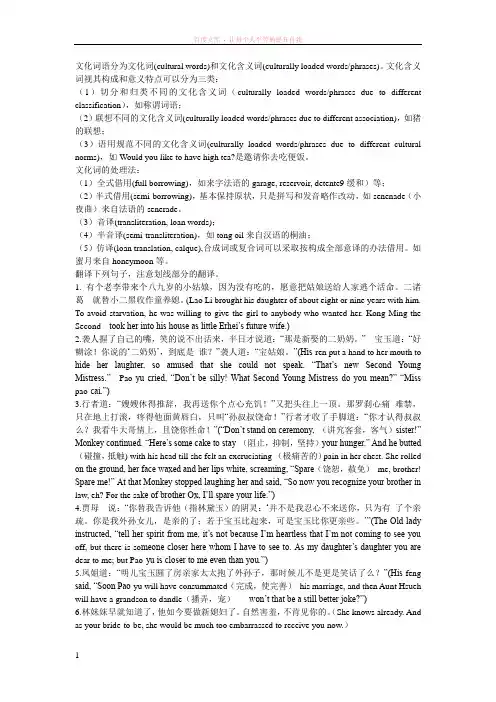
文化词语分为文化词(cultural words)和文化含义词(culturally loaded words/phrases)。
文化含义词视其构成和意义特点可以分为三类:(1)切分和归类不同的文化含义词(culturally loaded words/phrases due to different classification),如称谓词语;(2)联想不同的文化含义词(culturally loaded words/phrases due to different association),如猪的联想;(3)语用规范不同的文化含义词(culturally loaded words/phrases due to different cultural norms),如Would you like to have high tea?是邀请你去吃便饭。
文化词的处理法:(1)全式借用(full borrowing),如来字法语的garage, reservoir, detente9缓和)等;(2)半式借用(semi-borrowing),基本保持原状,只是拼写和发音略作改动,如senenade(小夜曲)来自法语的senerade。
(3)音译(transliteration, loan words);(4)半音译(semi-transliteration),如tong oil来自汉语的桐油;(5)仿译(loan translation, calque),合成词或复合词可以采取按构成全部意译的办法借用。
如蜜月来自honeymoon等。
翻译下列句子,注意划线部分的翻译。
1. 有个老李带来个八九岁的小姑娘,因为没有吃的,愿意把姑娘送给人家逃个活命。
二诸葛---就替小二黑收作童养媳。
(Lao Li brought his daughter of about eight or nine years with him. To avoid starvation, he was willing to give the girl to anybody who wanted her. Kong Ming the Second---took her into his house as little Erhei’s future wife.)2.袭人握了自己的嘴,笑的说不出话来,半日才说道:“那是新娶的二奶奶。
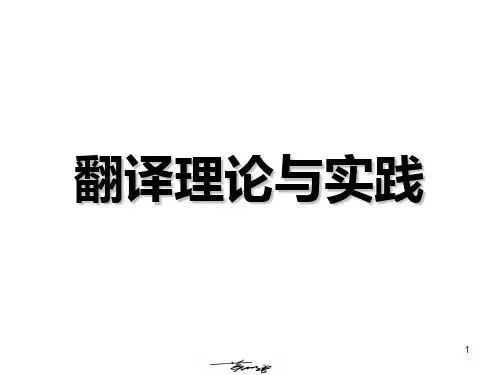
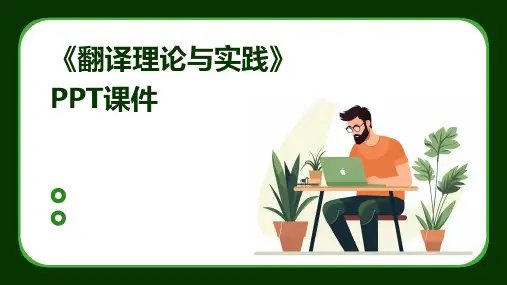

浅谈翻译理论与实践当今的世界,是一个开放的世界,各国在政治、经济、文化、体育、教育等各方面交流日益频繁和加深,在各国间的交流中,翻译已成为不可或缺的交际途径,翻译活动越来越频繁。
因此,对于翻译工作者来说,翻译是一项实践性很强的语言活动。
如果只有翻译实践没有翻译理论,那翻译水平就得不到提高。
实践是理论的基础,没有理论指导的实践是无源之水,没有实践证明的理论是无本之木。
这要求我们语言学习者对中西翻译发展的历史阶段有正确、清楚地认识是极为重要的。
本文对中西方翻译历史阶段及其翻译理论做了简洁地概括,旨在能对翻译工作者和翻译专业本专科生起到引导作用,帮助他们入门。
一带一路的战略构想体现了我国对外开放时发生的战略转移。
对外开放和国际上的合作交流都需要语言为桥梁,语言翻译便显得非常重要。
标签:翻译理论;翻译实践活动;中西翻译名家(一)那么人类为何会有翻译这样一种活动呢?在西方社会,人们认为翻译之出现,其重要原因在于人类的巴别塔情节。
《圣经·旧约·创世记》第11章提到,当时人类联合起来兴建希望能通往天堂的高塔;为了阻止人类的计划,上帝让人类说不同的语言,使人类相互之间不能沟通,计划因此失败,人类自此各散东西,建造通天塔的工程,也不得不搁置。
即便如此统一语言,达到沟通无障碍,这也一直是人类的一个夙愿。
获得奥斯卡提名的影片——Babel,(巴别塔)就是讲的贯穿在不同时间,不同地点和不同语言之间的人的故事。
影片的结束语写到”the brightest light in the darkest night”.寓意着即便是在沟通困难重重的环境下,人类还是克服一切阻力来达到信息传递和交流。
在中国,最早的翻译起源于《越人歌》的翻译,相传是中国第一首译诗。
鄂君子皙泛舟河中,打桨的越女爱慕他,用越语唱了一首歌,歌词中唱到“山有木兮木有枝,心悦君兮君不知”鄂君请人用楚语译出,就是这一首美丽的情诗。
有人说鄂君在听懂了这首歌,明白了越女的心之后,就微笑着把她带回去了。
翻译理论与实践(Translation theory and Practice)This paper consists of the 8888 contributionPpt documents may experience poor browsing on the WAP side. It is recommended that you first select TXT, or download the source file to the local view.Translation theory and PracticeI., What, is, translation, II., Is, it, to, translate, easy, III.,, Can, all, the, translated, words, be?I., What, is, translation?1, the definition of translation? 2, translation is to translate the text or? E.g.1:, My, sister, went, to, school, at, 7., e.g.2:, have you eaten? Where to? E.g.3: you're beautiful today! -- where?!II., Is, it, easy, to, translate?Henchman? Go back to man in the? The? Street? Crow s feet a hen party '? Fog lock hill mountain fog water disappears in the sky with rain window, two East West three point cut to carve up the piece, seven horizontal eight vertical knife knife toward the sea towards towards falling towards long clouds long long.III., Can, all, the, words, be, translated?According to the nephew lanterns (old uncle)? East sunrise rain, is (clear) the situation is a (clear)? --The professor shouted:Gentlemen, order --The entire class yelled:! "" Beer! "--Why is the river very? Rich? --Because it has two banks.You can cage a swallow, but you can t swallow a "cage. --The secret is going to? Be exposed, and we ll look pretty silly. --You" already look pretty and silly. bathing on bikini? Girl, eyeing, boy, finds boy eyeing bikini on bathing girl.Chapter 1The definition of translation, the purpose of translation, the type of translation, the standard of translation, the process of translation, the conditions for translationDefinition of translationTranslation is the practice of language in which the content of another language is re expressed in one language. Feng Qinghua? Translation is a kind of language (i.e., primitive) information in another language (the target language) express, so that the readers can get the original thoughts expressed by the author, are roughly the same as the original readers feel. - Fan Zhongying, translation is the translator's re understanding of the same thing and the use of another text. - Qiao HaiqingDefinition of translationTranslation is "an interpretation of verbal signs by means of some other language Translation is." Jakobson? "The replacement of textual material in one language (SL) byequivalent textual material in another language (TL). Catford Translation is the replacement of? A representation of a text in one language by a representation of an equivalent text in a second language. HudsonThe purpose of translationA bridge of communication and communication between different languages and cultures.Types of translationIntra language translation (intralingual translation) an interpretation of verbal signs by means of other signs in the same language (interlingual translation) translation? An interpretation of verbal signs by means of some other language? Intersemiotic translation (intersemiotic translation) an interpretation of verbal signs by means of nonverbal signs systemChinese translation theoriesYan Fu: Xindaya translation - Three: xindaya. It is hard to ask for a letter. Take care of the letter and fail to reach it,Even if you do not translate it, you will also interpret it. ? Lu Xun: faith, Shun - a course to make it easy, one is to preserve the original charm. / / faith rather than fluency? Qu Qiubai: the notion of equivalence translation should be the original intention, exactly China introduced to readers, make readers get China concept concept equal to other language from the textto the reader. Contradiction: to reproduce the artistic conception the highest task of literary translation is to reproduce the artistic conception so that the target readers can enjoy the beauty as much as the original.Chinese translation theoriesLiu Zhongde: letter, reach, cut letter: believe in content: as long as it is cut: to adapt to style, Zhang today: true, good, beautiful, truth: truth, principle, good: ideological principles: Beauty: artistic principlesForeign translation theoriesTytler: 1. The translation should the same effect on give a complete transcript of the ideas of the original work. style and manner of 2. The writing should be of the same character as that of the original. translation should have all 3. The the ease of the original composition.Federov: on Translation should produce a translation version which may be read with as much pleasure as the original, and yet remain faithful to its spirit, sense and style. Nida: dynamic equivalence theory readers get responses, and feelings with the original readers read the original income roughly equal. Newmark: text centered theoryProcess of translationIt is generally believed that the original text is understood expression Nida: original text testAnalytical translationTarget textRestructureFour steps: analysis, translation, reconstruction, testTranslation, from, English, to, Chinese:1., The, days, run, into, weeks., the days go by, for a few weeks.2. It, s, all, Greek, to, me., the translation condition, I do not understand at all. Mandarin Chinese is better than3. Mary has? A clever tongue. Marie (glib glib). English language ability is better than4., You, can, never, tell., wide knowledge, no one can say.5., My, memory, failed, me, at, that, moment., I can't remember that moment.6., Your, name, obstinately, escapes, me., I can't remember your name.7., To, think, that, you, should, fail., I don't think you will fail. 8., Would, it, were, otherwise, if that's not the case. There was more mischief than harm in him. he is only mischievous, and no harm. 10., I, never, go, past, my, old, school, but,, think, of, our, headmaster.. Every time I pass my alma mater, I remember our headmaster. 11., The, book, is, beyond, me., I can't read this book. 12., There, is, nothing, like, leather, for, shoes., leather shoes are great. 13., It, is, too, recent, to, be, forgotten., fresh in memory.14., The, mountain, is, not, valuable, because, it, is, high.,mountain is precious, not at its height. The "This is the last place I where expected to meet you." did not expect to meet you here. 16., He, is, nothing, if, not, stubborn., he's a stubborn man. 17., I, was, not, a, little, surprised., I was shocked.18., He, can, do, it, if, any, one, can., only he can do it.19. You cannot make something out of nothing. one can't make bricks without straw. 20., I, can, t, bear, the, sight,, of, that, man.I can't stand seeing that man.Similar sentences1. He had made a box., he has made a box. He had a box made., he told people to make a box.2. Foolishly he spoke. he was so foolish to speak. He spoke foolishly. he talks very stupid.3. Quite properly he was punished. he deserved to be punished. He was punished quite properly., he was properly punished.4., We, asked, him, to, speak, from, his, experience., we ask him to talk about it based on his experience. We asked him to speak about his experiences. we asked him to talk about his experience.Similar sentences5. He is behind time. he's late. He, is, behind, the, times., he's behind the times.6. His success is out of question. his success is beyond doubt. His, success, is, out, of, the, question, he's never going to be successful.7., They, went, to, sea., they're going to besailors. They, went, to, the, sea., they went to the beach. 8., It, has, been, raining, continually, for, two, days., rain, intermittent two days. It has, been, raining, continuously, for,, two, days rain continued for two days.Similar sentences9., He, has, no, more, than, ten, books., he has only ten books. He has not more than ten books., he has ten books at most.He is not a little afraid of it. he was very scared. He is not a bit afraid of it., he is not afraid at all. 11., I, didn, t, go, because, I, was, afraid., I am not afraid to go. I, didn, t, go, because, I, to., was, afraid, I did not go, because I dare not go. 12. She kept the house., she watches over the house. She kept house. her home.Similar sentences13., This, is, no, place, for, me, to, go., this is not whereI should go. There, is, no, place, for, me, to, go, I have nowhere to go. 14. I, had, a, good, talk, to, him, yesterday., I gave him a good dressing down yesterday. I had a good talk with him yesterday. I had a really good time talking to him yesterday. 15., Tom, escaped, prison., Tom escaped the jail. Tom, escaped, from, prison., Tom, jailbreak. 16., Is, there, any, difficulty, in, this? Do you have any difficulty with this? Is, there, some, difficulty, in, this? It's a bit difficult, isn't it?Similar sentencesWe are sure that man is mortal. we are sure that man will always die. We, are, sure, that, man, is, dead., we are sure the man is dead. 18., We, hired, the, boat, by, the, hour.. We ship by hour. We hired, the, boat, for, an, hour., we rented an hour boat.Similar sentences19., I, did, not, notice, him., I didn't notice him. I, took, no, notice, of, him., I don't care about him. 20., Happily, he, did, not, die., thankfully he did not die. He did not die happily., he died uneasy.The second chapter is semantic translationFirst, the choice of meaning in the understanding of polysemy (polysemy)The translation of runRun, a, car, run, shop, run, oil, run, message, a, fever, run, a, computer, run, run, a, meeting, run,, chickens, run, a, arms, advertisement, run, anHead translation10. He arranged his speech under five heads. his speech is divided into five parts. 11., We, have, thirty, head, of, cattle.We have thirty cows. 12., Heads, or, tails? Heads or tails? 13., Where, is, the, head? Where is the toilet?The translation of head:1. head of the English Department, director of the English Department of2. head of the government head of the bed, head of government3.4. head of the staircase a of the needle at the top of the stairs5. head6. He was badly wounded in a the head. he was badly wounded in the head.7. He has a good head for maths. he has a lot of mathematical talent.8., You, should, use, your, head., you should use your head.9. The, dinner, cost, US, five, dollars, a, head., the meal cost us 5 yuan each.The translation of I. poor:1. The, cloth, is, poor, in, quality., this cloth is of poor quality.2. The, water, is, poor, in, oxygen., this water is anoxic.3. Her first concert had a poor audience., her first concert, with very few listeners.4. This, to, her, was, a, poor, consolation., this comfort does not work for her.5. In my poor opinion, you should let her go. in my humble opinion, you should let her go. Boat. She was a poor sailor and always went to bed immediately on on getting the she has seasickness problems, so always go to bed on board.The translation of II. runThe He will not be running in the next election., he is not ready to run for the next election. 2., The, train, is, not, running, today., that train is off today. 3. The film began to run. filmat the. 4. His face was running with sweat. he Sweat streamed down the face. 5., It, was, such, a, ran., hot, day, that, the, butter, the weather was so hot that the butter melted. 6., The, road, runs, north., this road extends north. The "The rumor runs that he is going to resign." is rumoured that he is going to resign. 8., The, monsoon, had, six, weeks, more, to, run., the rainy season will last six weeks.The translation of II. run9., The, car, repair, will, run, you, at, least, two, hundred., repair, at least you spend two hundred yuan. 10. The play ran for only a week in that theatre.. The play was only staged for a week in that theater. 11., Potatoes, are, running, large, this, year., potatoes grow a lot this year. 12., A, freezer, doesn, run., t, cost, much, to, the use of the refrigerator is not very expensive.The translation of III. liveShe needs to find somewhere to live. she needs to find a place to live. 2., Where, do, these, plates, live? Where are these dishes? 3., Spiders, can, live, for, several, days, without, food., spiders can live without food for a few days. 4., We, saw, a, real, rattlesnake, live! We saw a live rattlesnake.The translation of III. live5. The club has live music most nights., the club has live music most nights.6. The show is going on live., the show is being broadcast live.7., Pollution, is, still, very, much, a, live,issue. pollution is still a very interesting issue at the moment.8., This, is, a, live, and, interesting, book., this is a lively and interesting book.The translation of IV. like1., He, likes, mathematics, more, physics., than, he prefers mathematics to physics.2., Bananas, don, t, like, me., I ate a banana and my stomach was upset. (bananas do not fit my stomach.) Three它的味道像芒果。
“翻译理论与实践”精品课程建设探索曾剑平;刘忠【摘要】对教学内容、教学手段、教学方法、教学评价以及翻译学科精品课程建设的规律等方面进行了系统研究和探索,为其他精品课程建设提供参考.【期刊名称】《新余学院学报》【年(卷),期】2011(016)005【总页数】3页(P114-116)【关键词】翻译理论与实践;精品课程;教学改革【作者】曾剑平;刘忠【作者单位】江西财经大学外国语学院,江西南昌330013;江西财经大学外国语学院,江西南昌330013【正文语种】中文【中图分类】G642.3课程建设是高校教学建设的中心工作之一,也是保证人才培养目标实现的重要举措,其水平直接影响着高校的教学水平和人才培养质量。
大学精品课程建设本着“开放和共享”的精神,旨在建设一批集合一流教师队伍、一流教学内容、一流教学方法、一流教材、一流教学管理等特点的示范性课程,为全面提高高等教育教学质量,培养一大批创新人才提供强有力的智力和技术支持。
[1]它在教学观念上,强调把握内涵、准确定位;在课程内容上,强调精选、优化与整合;在教学方法上,突出知识传授与能力培养并重的原则,强调探索基于网络教学的改革方法。
[2]我校(江西财经大学)的“翻译理论与实践”是江西省精品课程。
自2006年立项以来,我们对教学内容、教学手段、教学方法、教学评价以及翻译学科精品课程建设的规律等方面进行了系统研究和探索。
教学内容主要来源于教材。
现有的翻译教材虽然种类繁多,流派纷呈,但可供教学之用的实用教材并不多见。
有的教材重实践而轻理论;有的重理论而轻实践;有的重文学内容而轻其他文体内容,等等。
总之,如果取任何一套教材作为教学内容,都是不全面的。
为此,我们从多种翻译教材中精选、整合教学内容,增强实用性、广泛性和趣味性。
首先,系统整合翻译理论常识。
翻译理论常识是翻译课程必须掌握的知识,包括翻译概念、翻译种类、翻译本质、翻译标准、可译性和不可译性、翻译的过程、翻译技巧等。
翻译理论与实践的关系作者:夏甜来源:《校园英语》 2019年第31期【摘要】“世界大同,天下一家”的梦想是人类心中始终不灭的明灯。
改革开放、一带一路,世界各国人民正在为构建人类命运共同体而努力,沟通与协作是我们努力的方向,而翻译理论与实践正是保证这种沟通与协作关系持续下去之桥梁。
本文将结合翻译理论的内容,阐述与剖析其与实践之间错综复杂的关系。
【关键词】翻译理论;实践;关系【作者简介】夏甜,对外经济贸易大学英语学院在职人员高级课程研修班学员。
一、翻译理论与实践的发展我国翻译起于东汉至宋代的佛经翻译,那个时期的翻译可理解为“直译”,更形象的可理解为“死译”,直到支谦突破“直译”的界限,将文学艺术融入翻译当中,再到后来的鸠摩罗什才慢慢开始提倡“意译”。
五四运动后,我国的翻译学掀开了新的篇章,从此踏上了现代翻译的漫长征程,人们逐渐开始注重翻译理论与翻译实践的结合。
翻译理论在我国学者们和爱好者们无数次碰壁与日夜探究中不断发展,不断完善并逐渐形成教学体系。
随着改革开放的深入,翻译活动已不仅仅是一种学习与交流的基本工具,历史和时代的发展赋予了它更加重要的地位与使命。
翻译活动为我国乃至全球的沟通发展,互动交流作出了不可磨灭的贡献。
当然,在我国仍然缺乏高度统一且被大众所认可的翻译理论体系译学,有些专家、学者一味讲究翻译的深度、全度,忽视了现代翻译的目的和意义。
二、翻译理论与实践的关系高水平的翻译从来不是一蹴而就,让目标语读者像听到、看到母语般的译文,获得源语表达者真正想阐述的目的和信息才是翻译最终的意义所在。
这一切需要翻译理论、技巧以及方法的支持与约束,也需要实践活动提供的“养分”,使翻译内容变得饱满、贴切,使其成为连接源语者与读者、听者之间的纽带。
1.翻译理论与实践的主导关系。
辞海一书里对翻译理论给予的解释是:翻译理论出现的一个主要意义就是其可以对人们自身行为进行指导。
理论是概念以及原理上的主要体系;是相对系统化的理性认知。
1、词语的意义:(1)指称意义:是语言符号和它所描绘或叙述的主观世界或客观世界的实体和事件之间的关系。
指称意义和字面意义(literal meaning)虽然在大部分情况下是重合的,却是两个不同角度去看的两个不同概念。
字面意义是单个词语最先在语言使用者脑中唤起的概念或形象。
如Indian meal(指称意义指“玉米粥”,字面意义是“印第安饭”)和Indian summer (指称意义指“小阳春”,字面意义是“印第安夏天”)。
类似的有American Beauty(月月红)和German wool(细毛线)。
(2)言内意义:是语言符号之间的关系,包括传统语义学的系统意义(即词在特定语言词汇结构系统中的地位,即词的值)。
言内意义可以从音系意义,语法意义和词汇意义上考虑。
(3)语用意义:包括表征意义、表达意义、社交意义、祈使意义和联想意义等。
2、翻译下面划线部分的词语(1)我因坎坷一生碌碌无为而遗憾。
(I regret few achievements in a troubled(不安的,忧虑的,动乱的)life.)(2)龙船节,是黔东南清水江上苗族人民最盛大的节日。
节日里,聚会的苗族同胞,每年有三四万。
(The Dragon-Boat Festival is the most important celebration(庆祝,庆祝会)of the Miao people, who live along the Qingshui River in southeastern Guizhou Province. Every year between 30000 and 40000 Miao participate in the festivities(节日,节日活动).)(3)吃、穿、住、行、用等各方面的工业品,包括彩电、冰箱、洗衣机,都大幅度增长。
(Production of processed food, clothing, housing, transportation and commodities for daily use, including major appliances such as colour TV sets, refrigerators and wahing machines, increased by a wide margin.)(4)全部成品出厂前必须在实验室里进行检验,严格把关,一丝不苟。
(All products must be inspected strictly and scrupulously in the lab of the factory before delivery.)(5)我记得那时我的打扮挺滑稽的,穿着蓝布大褂、小坎肩,戴瓜皮小帽。
(I still remember how funny I looked the way I was dressed---in a blue cloth gown(长袍,长外衣)with a short sleeveless jacket over it and a skull cap (室内便帽)on the head.)(6)他听傅芳把共产党说成神出鬼没似的,便觉得非常有趣。
(He was immediately tickled (逗乐,使高兴,觉得痒)by Fufang’s account of elusive,(躲避的,难以理解的)will-o’-the-wisp (鬼火,磷火,捉摸不定的东西)communists.)(7)对于我们的这样发展中的大国来说,经济要发展得快一点,不可能总是那么平平静静、稳稳当当。
(For a major developing nation like China, it is impossible to attain a slightly faster economic growth always at such a calm and smooth pace.)(8)南京,她有层出不穷的风流人物和彪炳千秋的不朽业绩。
大都会特有的凝聚力,吸引了无数风云人物、仁人志士在这里角逐争雄、一逞英豪。
(Nanjing has witnessed the continuous emergence of many distinguished talents and noble hearts as well as monumental achievements that shone through the ages. Attracted by her special appeals, 9感染力,号召力)a great number of powerful figures and people actuated by high ideas have stayed in or frequented this metropolis to contend for the lead (主角,榜样)or to give play to their genius and virtues.)(9)黄色的花淡雅,白色的花高洁,紫色的花热烈而深沉。
泼泼洒洒,秋风中正开得烂漫。
(The yellow ones were simple and elegant; the white ones, pure and noble; and the purple ones, warm and deep; all were in full bloom, dancing in the autumn breeze.)(10)在四川,有一美妙去处。
它背依岷山主峰雪宝顶,树木苍翠,花香袭人,鸟声婉转,流水潺潺。
名胜古迹荟萃,这就是松潘县的黄龙。
(One of Sichuan’s finest scenic spots is Huanglong (Yellow Dragon), which lies in Songpan County just beneath Xuebao, the main peak of the Minshan Mountains. Its lush(茂盛的,葱翠的) green forests, filled with fragrant flowers,bubbling streams, and songbirds, are rich in historical interest as well as natural beauty.)(11)西湖如明镜,千峰凝翠,洞壑幽深,风光奇丽。
(The West Lake is like a mirror embellished all around with green hills and deep caves of enchanting beauty.)(12)他笔下的翎毛花卉,墨彩交融,无不栩栩如生,具有强烈的感染力。
(His resplendent (灿烂的,辉煌的,华丽的)flower-and-bird paintings, executed with easy command of the brush, are noted for their elegant fine lines and delicate colours blended with splash-ink in perfect harmony.)(13)没有盼头的日子是苍白不可想象的。
人,得天天有点什么盼头,生活才不至于暗淡。
(A day without hope would be unimaginably pale. There must be something to look forward to each day to brighten one’s life and keep it out of shadows.)(14)跑了不知多少趟,总算有眉目了,又得往这一处签字,那一处盖章,看种种脸色,候种种传唤,为的是得一份充分的证明,可以去换张票子。
(After making you don’t know how many visits, there eventually appear signs of a positive outcome. Then you have to go here and there to get a signature or a seal, meet with all sorts of cold reception and wait for all sorts of summonses(召唤,命令)-----all for the purposes of obtaining a useful certificate to buy a ticket with.)(15)就四川的名山秀水而论,总是有他们各自的独特风格和个性。
如峨嵋山的“秀”,青城山的“幽”,剑门山的“险”,夔门的“雄”。
(Sichuan Province is rich in scenic wonders, each with its own distinctive features-----the elegance of Mount Emei, the serenity of Mount Qingcheng, the sharp precipice(悬崖,峭壁)of Jiamen Pass, and the grandeur of Kuimen.)(16)打得赢就打,打不赢就走。
(Fifht when you can win, move away when you cannot win.) (17)这小子干活真冲。
(This young fellow does his work with vim(活力,精力)and vigor. be full of vim and vigor精力充沛)(18)(大家快走啊,前面是无锡胜景之一,)先睹为快啊!(The sooner you see, the happier you will be!)(19)抱着书生之见,我决定坐木船。
(It was with this impractical view that I decided to take a wooden boat.)(20)他把事情一五一十都给父母讲了。
(True to type he told his parents the whole story.)(true to type典型的(地),合乎本性的(地),与原样相同的)(21)我的邻居是一位六十多岁的老太太,隔三差五,到街头饭馆改善一次生活。